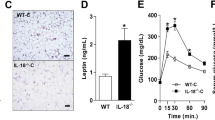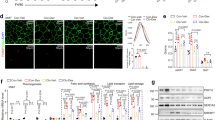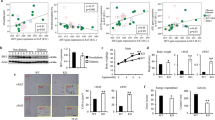Abstract
Objective:
The serum- and glucocorticoid-regulated kinase 1 (SGK1) is an early transcriptional target of glucocorticoids and is activated via insulin. Here we investigate the regulation of SGK1 expression in human obesity, diet-induced murine obesity and human monocytic cell line THP-1 monocytes.
Subjects and methods:
SGK1 expression was studied in subcutaneous and omental adipose tissue (AT) of 20 morbidly obese and 20 age- and gender-matched non-obese controls in murine diet-induced obesity and the THP-1 cell line. The regulation of SGK1 by inflammatory signals was tested in THP-1 cells.
Results:
Murine diet-induced obesity is associated with a significant upregulation of Sgk1 in gonadal AT. Sgk1 expression is highest in the macrophage-rich stromal vascular fraction and lower in adipocytes. In humans, AT SGK1 is predominantly expressed in CD14+ macrophages and significantly upregulated in omental and subcutaneous AT of obese subjects. SGK1 mRNA expression in both omental and subcutaneous AT correlates with body mass index, circulating leptin and C-reactive protein, and the local expression of inflammatory markers including monocyte chemotactic protein-1 and macrophage inflammatory protein-1α. The expression of SGK1 in THP-1 cells is upregulated by inflammatory signals, such as lipopolysaccharide and tumour necrosis factor-α, as well as during the induction of monocyte-to-macrophage maturation.
Conclusions:
Our data present the first link between SGK1 and obesity-associated inflammation. SGK1 expression is stimulated in response to inflammatory signals and increased in AT macrophages. The characterisation of SGK1 functions in obesity and immunity may help identify potential therapeutic targets in the treatment of obesity.
This is a preview of subscription content, access via your institution
Access options
Subscribe to this journal
Receive 12 print issues and online access
$259.00 per year
only $21.58 per issue
Buy this article
- Purchase on Springer Link
- Instant access to full article PDF
Prices may be subject to local taxes which are calculated during checkout




Similar content being viewed by others
References
Park J, Leong ML, Buse P, Maiyar AC, Firestone GL, Hemmings A . Serum and glucocorticoid-inducible kinase (SGK) is a target of the PI 3-kinase-stimulated signaling pathway. EMBO J 1999; 18: 3024–3033.
Artunc F, Amann K, Nasir O, Friedrich B, Sandulache D, Jahovic N et al. Blunted DOCA/high salt induced albuminuria and renal tubulointerstitial damage in gene-targeted mice lacking SGK1. J Mol Med (Berl) 2006; 84: 737–746.
Lang F, Stournaras C, Alesutan I . Regulation of transport across cell membranes by the serum- and glucocorticoid-inducible kinase SGK1. Mol Membr Biol 2014; 31: 29–36.
Palmada M, Boehmer C, Akel A, Rajamanickam J, Jeyaraj S, Keller K et al. SGK1 kinase upregulates GLUT1 activity and plasma membrane expression. Diabetes 2006; 55: 421–427.
Dieter M, Palmada M, Rajamanickam J, Aydin A, Busjahn A, Boehmer C et al. Regulation of glucose transporter SGLT1 by ubiquitin ligase Nedd4-2 and kinases SGK1, SGK3, and PKB. Obes Res 2004; 12: 862–870.
Fujita Y, Kojima H, Hidaka H, Fujimiya M, Kashiwagi A, Kikkawa R . Increased intestinal glucose absorption and postprandial hyperglycaemia at the early step of glucose intolerance in Otsuka Long-Evans Tokushima Fatty rats. Diabetologia 1998; 41: 1459–1466.
Heikamp EB, Patel CH, Collins S, Waickman A, Oh MH, Sun IH et al. The AGC kinase SGK1 regulates TH1 and TH2 differentiation downstream of the mTORC2 complex. Nat Immunol 2014; 15: 457–464.
Anagnostis P, Athyros VG, Tziomalos K, Karagiannis A, Mikhailidis DP . Clinical review: The pathogenetic role of cortisol in the metabolic syndrome: a hypothesis. J Clin Endocrinol Metab 2009; 94: 2692–2701.
Lang F, Voelkl J . Therapeutic potential of serum and glucocorticoid inducible kinase inhibition. Expert Opin Investig Drugs 2013; 22: 701–714.
Li P, Pan F, Hao Y, Feng W, Song H, Zhu D . SGK1 is regulated by metabolic-related factors in 3T3-L1 adipocytes and overexpressed in the adipose tissue of subjects with obesity and diabetes. Diabetes Res Clin Pract 2013; 102: 35–42.
Di Pietro N, Panel V, Hayes S, Bagattin A, Meruvu S, Pandolfi A et al. Serum- and glucocorticoid-inducible kinase 1 (SGK1) regulates adipocyte differentiation via forkhead box O1. Mol Endocrinol 2010; 24: 370–380.
Weisberg SP, McCann D, Desai M, Rosenbaum M, Leibel RL, Ferrante AW Jr . Obesity is associated with macrophage accumulation in adipose tissue. J Clin Invest 2003; 112: 1796–1808.
Maachi M, Pieroni L, Bruckert E, Jardel C, Fellahi S, Hainque B et al. Systemic low-grade inflammation is related to both circulating and adipose tissue TNFalpha, leptin and IL-6 levels in obese women. Int J Obes Relat Metab Disord 2004; 28: 993–997.
Suganami T, Mieda T, Itoh M, Shimoda Y, Kamei Y, Ogawa Y . Attenuation of obesity-induced adipose tissue inflammation in C3H/HeJ mice carrying a Toll-like receptor 4 mutation. Biochem Biophys Res Commun 2007; 354: 45–49.
Ye J . Emerging role of adipose tissue hypoxia in obesity and insulin resistance. Int J Obes (Lond) 2009; 33: 54–66.
Fried SK, Bunkin DA, Greenberg AS . Omental and subcutaneous adipose tissues of obese subjects release interleukin-6: depot difference and regulation by glucocorticoid. J Clin Endocrinol Metab 1998; 83: 847–850.
Fain JN, Madan AK, Hiler ML, Cheema P, Bahouth SW . Comparison of the release of adipokines by adipose tissue, adipose tissue matrix, and adipocytes from visceral and subcutaneous abdominal adipose tissues of obese humans. Endocrinology 2004; 145: 2273–2282.
Huber J, Kiefer FW, Zeyda M, Ludvik B, Silberhumer GR, Prager G et al. CC chemokine and CC chemokine receptor profiles in visceral and subcutaneous adipose tissue are altered in human obesity. J Clin Endocrinol Metab 2008; 93: 3215–3221.
Kiefer FW, Zeyda M, Todoric J, Huber J, Geyeregger R, Weichhart T et al. Osteopontin expression in human and murine obesity: extensive local up-regulation in adipose tissue but minimal systemic alterations. Endocrinology 2008; 149: 1350–1357.
Zeyda M, Farmer D, Todoric J, Aszmann O, Speiser M, Gyori G et al. Human adipose tissue macrophages are of an anti-inflammatory phenotype but capable of excessive pro-inflammatory mediator production. Int J Obes (Lond) 2007; 31: 1420–1428.
Nabokikh A, Ilhan A, Bilban M, Gartner W, Vila G, Niederle B et al. Reduced TGF-beta1 expression and its target genes in human insulinomas. Exp Clin Endocrinol Diabetes 2007; 115: 674–682.
Reiter MH, Vila G, Knosp E, Baumgartner-Parzer SM, Wagner L, Stalla GK et al. Opposite effects of serum- and glucocorticoid-regulated kinase-1 and glucocorticoids on POMC transcription and ACTH release. Am J Physiol Endocrinol Metab 2011; 301: E336–E341.
Holness CL, Simmons DL . Molecular cloning of CD68, a human macrophage marker related to lysosomal glycoproteins. Blood 1993; 81: 1607–1613.
Nishida Y, Nagata T, Takahashi Y, Sugahara-Kobayashi M, Murata A, Asai S . Alteration of serum/glucocorticoid regulated kinase-1 (sgk-1) gene expression in rat hippocampus after transient global ischemia. Brain Res Mol Brain Res. 2004; 123: 121–125.
Rusai K, Wagner B, Roos M, Schmaderer C, Strobl M, Boini KM et al. The serum and glucocorticoid-regulated kinase 1 in hypoxic renal injury. Cell Physiol Biochem 2009; 24: 577–584.
Kobayashi T, Cohen P . Activation of serum- and glucocorticoid-regulated protein kinase by agonists that activate phosphatidylinositide 3-kinase is mediated by 3-phosphoinositide-dependent protein kinase-1 (PDK1) and PDK2. Biochem J 1999; 339: 319–328.
Lumeng CN, Deyoung SM, Saltiel AR . Macrophages block insulin action in adipocytes by altering expression of signaling and glucose transport proteins. Am J Physiol Endocrinol Metab 2007; 292: E166–E174.
Cowling RT, Birnboim HC . Expression of serum- and glucocorticoid-regulated kinase (sgk) mRNA is up-regulated by GM-CSF and other proinflammatory mediators in human granulocytes. J Leukoc Biol 2000; 67: 240–248.
McNelis JC, Olefsky JM . Macrophages, immunity, and metabolic disease. Immunity 2014; 41: 36–48.
Cancello R, Henegar C, Viguerie N, Taleb S, Poitou C, Rouault C et al. Reduction of macrophage infiltration and chemoattractant gene expression changes in white adipose tissue of morbidly obese subjects after surgery-induced weight loss. Diabetes 2005; 54: 2277–2286.
Acknowledgements
We thank L-I Ionasz for expert technical assistance.
Author information
Authors and Affiliations
Corresponding author
Ethics declarations
Competing interests
The authors declare no conflict of interest.
Rights and permissions
About this article
Cite this article
Schernthaner-Reiter, M., Kiefer, F., Zeyda, M. et al. Strong association of serum- and glucocorticoid-regulated kinase 1 with peripheral and adipose tissue inflammation in obesity. Int J Obes 39, 1143–1150 (2015). https://doi.org/10.1038/ijo.2015.41
Received:
Revised:
Accepted:
Published:
Issue Date:
DOI: https://doi.org/10.1038/ijo.2015.41



